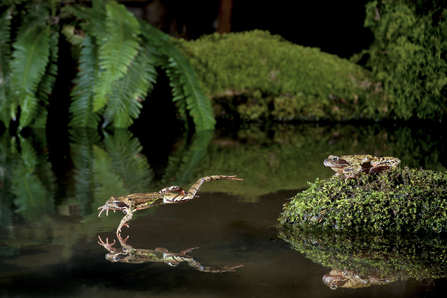
Common frogs by Dale Sutton
One of the benefits of a clean water pond is that once the hard work of digging is complete, relatively little management is required. Generally, the less done to a pond the better; something that is particularly true when it comes to planting up.
It is often assumed that new ponds should be planted-up to transform them from being ‘barren’ habitats, but by ‘leaving it to nature’ your pond will be populated by species suited to the substrate, while also providing habitat for species that prefer ‘new ponds’.
Avoid planting up farm ponds
If you let pond plants arrive naturally on the feet of duck and by wind, or dormant seeds in the pond substrate of a restored pond, you will be surprised how quickly plants will turn up on their own – usually within the first summer of establishing or restoring the pond.
The plants that do colonise will be those best suited to the pond substrate. Water beetles, mayflies, dragonflies and other mobile insects will fly in very quickly and if habitat connections are good (such as hedge, ditch or grassland links), amphibians such as newts won’t be far behind. Flatworms and snails usually arrive a few years later.
A pond in early stages of succession provides an important habitat for species which like the relatively bare conditions both within the water and on the banks – and sometimes occasional subsequent management is beneficial to re-create these bare banks for species such as dragonflies that like to sunbathe. These ‘new pond’ plants and animals often disappear after a few years as ponds become too mature.
Pond planting exceptions
There are a few occasions where planting up ponds may be appropriate.
Bank erosion: Wind or wave erosion or high numbers of duck can erode vulnerable new pond banks. In these situations, it is important to plant tough species which will form stands of vegetation that will help protect the banks, and often provide small backwater habitats where aquatic species are protected too. Pond design is important to ensure that an underwater ‘shelf’ has a relatively steep cut-off to slow down the spread of invasive vegetation over the entire pond. It may be worth using coir-fibre, ideally planted with locally appropriate plants, or bought pre-planted, to help protect banks quickly.
Garden ponds: Where ‘gardening’ a small pond is important and regular management is both possible and desirable, the temptation to establish particular pond plants as part of a garden design may be overwhelming. Similarly, if one is trying to create an instant ‘landscaped’ pond for aesthetic reasons, there may be justification in speeding up the natural process by planting. If doing so, there are some golden rules to follow.
Golden rules for pond planting
Avoid inadvertently introducing alien, invasive species which out-compete our native pond plants and pose a threat to our native invertebrates, amphibians and fish by blocking out heat and light from the water. These are sometimes sold as oxygenating plants in garden centres, or, fragments of them may have got into pots of other plants (some stores only stock native only plants to reduce this problem).
Once in a pond situation, these invasive species grow rampantly and - once established - are often impossible to control. Such species most commonly found in Suffolk’s ponds and to be avoided are the following:
• New Zealand pygmyweed or swamp stonecrop can grow on both land and water and completely take over a pond.
• Water fern or fairy moss, a tiny floating leaved plant, which smothers the pond surface, especially in sheltered situations.
• Parrotsfeather can appear pretty in a goldfish bowl but once in a pond situation becomes very difficult to manage.
• Canadian pondweed is often sold as an oxygenating plant but once in a pond can fill the waterbody and require regular removal.
• Curly waterweed resembles Canadian pondweed and is often sold as oxygenating Elodea crispa in garden centres. This can similarly fill ponds.
Use plants that occur locally
Ideally, find a donor farm pond source nearby that does not support invasive, alien species that could be a real nuisance on the recipient pond.
Remember that all plants won’t suit all soil types and different plants often dominate in some years so if you plant a huge variety, the chances are they won’t all thrive.
Do some homework to establish whether the pond plants – native or otherwise – you intend to transplant are suitable for the size of recipient pond. Often, small ponds can be swamped by native invasive vegetation that is quite appropriate and in check in a large pond.
| Non-exhaustive list of native pond plants found in Suffolk – most colonise their favoured soil type naturally in time, while some can become invasive and problematic in small or sheltered ponds | |
| Submerged ‘oxygenators’ | Hornwort Spiked water-milfoil (can be very invasive), Water crowfoot Water starwort Curled pondweed (good for newts in steep-edged ponds where few marginal plants) |
| Floating leaved plants |
Floating leaved plants Amphibious bistort Frogbit Broad-leaved pondweed Water crowfoot Water soldier (very invasive, problematic in ponds) |
| Emergent plants (most of these can be very invasive, but equally quite good at protecting vulnerable banks) | Bogbean Branched bur-reed Flowering rush Yellow flag |
| Marginal (tolerant of fluctuating water levels and regular drying out) | Brooklime Gipsywort Marsh marigold (not on clay) Water-forget-me-not (good for great crested newts) Water mint (good for great crested newts) Water plantain Water speedwell |
| Marshy conditions next to pond | Hemp agrimony Marsh woundwort Meadowsweet Purple loosestrife Ragged robin Rushes/sedges (invasive, good bank protection) |
